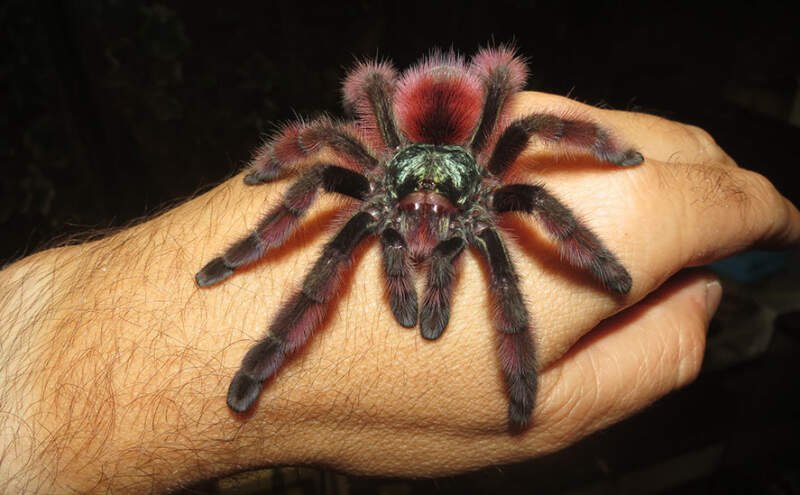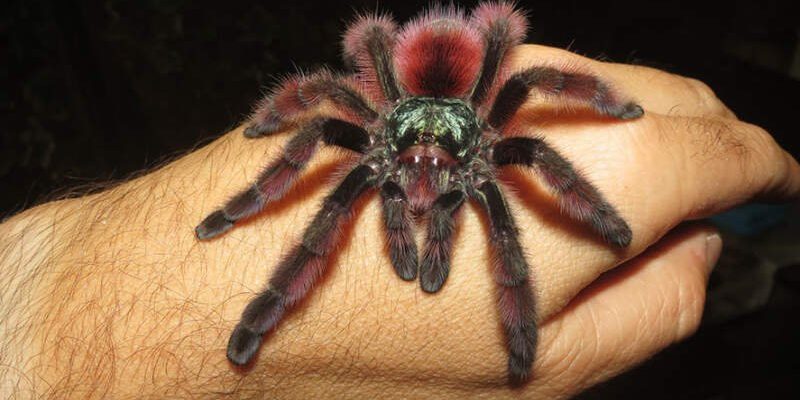
You might be wondering what makes these tarantulas, scientifically known as *Avicularia avicularia*, so special. They originate from the lush rainforests of South America, where they climb trees and weave intricate webs. With their colorful legs and somewhat docile temperament, pink toe tarantulas have become popular in the pet trade. But there’s a lot more to these spiders than meets the eye, and that’s what we’re going to explore together.
Physical Characteristics
When you first see a pink toe tarantula, you can’t help but notice its vibrant legs. The pink coloration on their toes contrasts sharply with their dark, furry bodies. This isn’t just for show; these colors can help them blend in with the rainforest environment, making them less visible to predators.
Their body size is also pretty impressive. Adult pink toe tarantulas typically stretch out to about 4 to 5 inches in body length, but when you add in their leg span, they can reach nearly 10 inches! Just imagine a creature that big hanging out in your living room. And let’s not forget those beautiful, silky webs they spin. They create these webs in trees, showcasing their arboreal nature.
Here’s the thing: while they may look intimidating, pink toe tarantulas are usually quite gentle. They’re not known for aggressive behavior, which is a bonus for beginners wanting to keep a tarantula as a pet. Their unique adaptations make them a joy to observe, whether you’re an expert or just starting your journey into the world of tarantulas.
Habitat and Distribution
Pink toe tarantulas thrive in tropical rainforests across South America. Countries like Brazil, Guyana, and Venezuela are home to these fascinating creatures. They prefer living high up in the trees, where they build their homes in the foliage. This arboreal lifestyle means they can avoid many ground-based predators while also having a steady source of food.
In these forest canopies, they feast mainly on insects like crickets and roaches, but they’ll also go after small vertebrates when the opportunity arises. Honestly, it’s a spider’s life that might remind you more of a fairy tale than a creepy crawly. Imagine living in a lush green paradise, catching your meals mid-air like a master of the jungle!
Keeping a pink toe tarantula requires mimicking their natural habitat as closely as possible. If you’re considering one as a pet, you’ll need a tall enclosure that allows them to climb and spin webs comfortably. Proper humidity and temperature levels are essential, too, so be prepared to do a bit of homework to keep your new friend happy.
Behavior and Temperament
When it comes to behavior, pink toe tarantulas have some quirks that are fascinating to observe. They are generally more active than many other tarantula species. You might find them climbing around their enclosure, exploring every nook and cranny. Their agility and inquisitive nature can be captivating to watch—almost like having a tiny pet monkey!
Let me explain: although they can be skittish, especially when they feel threatened, they rarely bite. Instead, they often display defensive behaviors like kicking urticating hairs (fine hairs that can irritate skin) or retreating to the safety of their web. This means they might not be the best choice for those looking for a cuddle buddy, but they still offer mesmerizing and engaging interactions.
As a pet owner, handling a pink toe tarantula requires caution. While they aren’t aggressive, it’s always smart to approach them gently to avoid startling them. Many enthusiasts find joy in simply observing their behavior, which can be just as rewarding as handling them.
Feeding Your Pink Toe Tarantula
Feeding a pink toe tarantula is fairly straightforward, but it does require some attention to detail. In the wild, they primarily eat insects, so replicating this diet is essential in captivity. Crickets and mealworms are commonly used, but you can also include other insects like roaches and fruit flies.
Here’s the thing: it’s important to provide appropriately sized prey. A good rule of thumb is to feed your tarantula insects that are about the size of its body. Overfeeding can lead to health issues, so aim for once or twice a week, depending on its age.
Make sure to regularly dust the insects with calcium and vitamin supplements to ensure your tarantula gets the nutrients it needs. If you notice that your pink toe is refusing to eat, don’t panic—sometimes they can go through periods of fasting, especially during molting.
Handling and Care Tips
If you’re a new pink toe tarantula owner, you’ll want some solid tips for handling and caring for your new eight-legged friend. First off, it’s crucial to create a comfortable habitat. You’ll need a tall terrarium with plenty of climbing space, substrate for burrowing, and proper humidity levels (around 65-75%).
Honestly, the key to successfully keeping a pink toe tarantula is to minimize stress. Avoid frequent handling, especially when they are acclimating to their new environment. If you do want to handle them, give them time to warm up to you first. Start by offering your hand slowly and let them walk onto it at their own pace.
Always ensure your hands are clean, and avoid wearing any perfumes or lotions that could irritate their sensitive bodies. Also, be prepared for the occasional escape artist! Making sure your enclosure is secure can prevent any unintended adventures around your home.
Common Myths and Misconceptions
There are plenty of myths floating around about tarantulas, and the pink toe is no exception. One common misconception is that they are all dangerous and aggressive creatures. While some tarantula species can be defensive, pink toes are generally known for their docile nature. This makes them an excellent choice for beginners.
Another myth is that tarantulas are deadly to humans. While their bites can be painful and cause some discomfort, they are not life-threatening to healthy adults. It’s always smart to treat them with respect and avoid any unnecessary handling, but panic is unnecessary.
You might also hear that tarantulas are not suitable pets because they live in cages. Let me explain: many owners find joy in creating beautiful setups for their tarantulas, turning their enclosures into mini rainforests. A bit of creativity and care can make a tarantula an interesting and unique addition to your home.
Pink toe tarantulas are truly captivating creatures. With their vibrant appearance, gentle temperament, and interesting behaviors, they offer a unique pet experience that many enthusiasts cherish. Whether you’re considering one as a pet or just intrigued by them, understanding these spiders can enhance your appreciation for the diversity of life on our planet.
So next time you think about the world of tarantulas, remember the enchanting pink toe. They might just be the surprising star of the arachnid world, proving that beauty and grace can come in even the most unexpected forms. With the right care and understanding, these wonderful creatures can become fascinating companions that bring joy and curiosity to your life.

